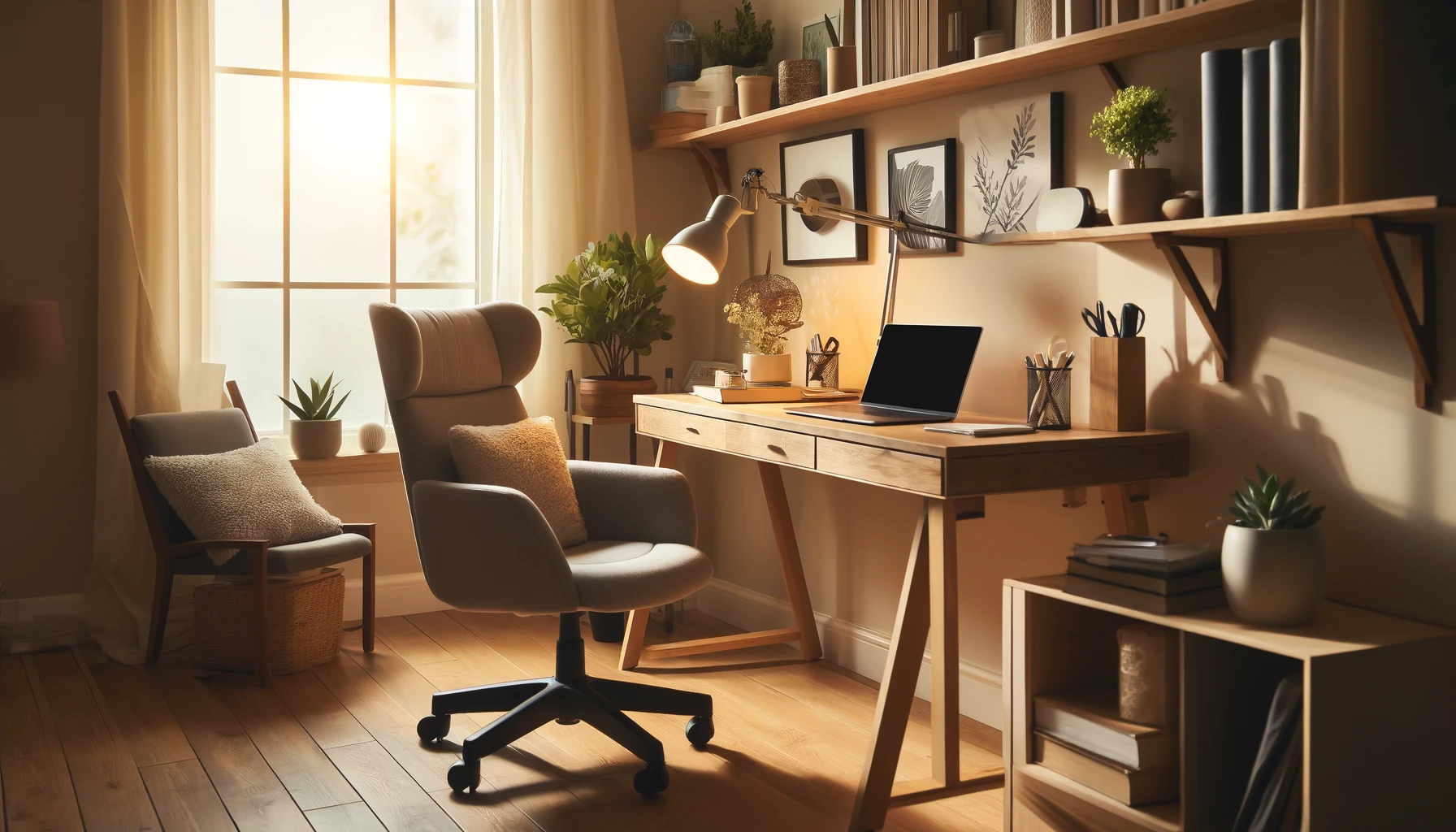As remote work becomes increasingly prevalent, creating an efficient home office setup has become essential for productivity and well-being. A well-designed home office setup can enhance focus, reduce stress, and boost overall work performance. In this article, we will discuss key elements for setting up a productive home office space, including furniture, lighting, and equipment.
Furniture: Foundation of Your Home Office Setup
The right furniture forms the backbone of an efficient home office setup. Here are some essential pieces and considerations:
Ergonomic Chair: Investing in an ergonomic chair is crucial for maintaining good posture and preventing back pain. Look for a chair with adjustable height, lumbar support, and comfortable padding. An ergonomic chair should support your natural spine curvature and allow you to sit comfortably for extended periods.
Sturdy Desk: A sturdy desk is essential for an efficient workspace. Choose a desk with ample surface area to accommodate your computer, keyboard, mouse, and other work essentials. Consider an adjustable standing desk, which allows you to alternate between sitting and standing, promoting better posture and reducing the risk of sedentary-related health issues.
Storage Solutions: Clutter can hinder productivity. Incorporate storage solutions such as filing cabinets, shelves, and desk organizers to keep your workspace tidy. Proper storage helps you stay organized, making it easier to find documents and supplies when needed.
Lighting: Brighten Your Home Office Setup
Proper lighting is essential for reducing eye strain and creating a pleasant work environment. Here are some tips for optimizing your home office setup lighting:
Natural Light: Natural light is the best source of illumination. Position your desk near a window to take advantage of natural light. This not only reduces the need for artificial lighting but also enhances your mood and energy levels. Be mindful of glare on your computer screen; use blinds or curtains to control the amount of sunlight.
Task Lighting: In addition to natural light, incorporate task lighting to focus on specific work areas. A good desk lamp with adjustable brightness and angle can provide the right amount of light for reading, writing, and other detailed tasks. Choose a lamp with LED bulbs, which are energy-efficient and long-lasting.
Ambient Lighting: Ambient lighting creates a balanced and comfortable light level throughout the room. Consider overhead lights, floor lamps, or wall-mounted fixtures to provide general illumination. Use dimmer switches to adjust the light intensity according to the time of day and your personal preference.
Avoid Harsh Lighting: Avoid harsh, direct lighting that can cause glare and discomfort. Opt for diffused lighting that spreads evenly across your workspace. Soft, warm light tones are generally more relaxing and conducive to a productive work environment.
Equipment: Tools for an Efficient Home Office Setup
Having the right equipment is essential for a smooth and productive home office setup. Here are some key pieces of equipment to consider:
Computer and Monitor: A reliable computer is the cornerstone of your home office setup. Depending on your work requirements, you may need a desktop or a laptop with sufficient processing power, memory, and storage. A high-quality monitor can reduce eye strain and enhance productivity. Consider a dual-monitor setup if your work involves multitasking or extensive screen real estate.
Keyboard and Mouse: Invest in a comfortable keyboard and mouse to prevent strain on your hands and wrists. Ergonomic designs can reduce the risk of repetitive strain injuries. Wireless options can help reduce cable clutter and provide more flexibility in arranging your workspace.
High-Speed Internet: A fast and stable internet connection is vital for remote work. Ensure you have a reliable internet service provider and consider upgrading your plan if necessary. A good Wi-Fi router can improve connectivity throughout your home office setup.
Headset and Webcam: For virtual meetings and video calls, a good headset and webcam are essential. A noise-canceling headset can improve audio quality and reduce background noise, while a high-definition webcam ensures clear video communication.
Backup Solutions: Data loss can be catastrophic. Implement backup solutions such as external hard drives, cloud storage, or network-attached storage (NAS) to safeguard your important files. Regularly back up your data to prevent loss due to hardware failure or other unforeseen events.
Power Backup: Invest in an uninterruptible power supply (UPS) to protect your equipment from power outages and surges. A UPS provides backup power, allowing you to save your work and shut down your devices properly during a power failure.
Additional Tips for an Efficient Home Office Setup
Personalize Your Space: Personalize your home office setup with items that inspire and motivate you. This could include artwork, plants, or personal mementos. A personalized workspace can boost your mood and make you feel more connected to your environment.
Maintain a Clean and Organized Space: A clean and organized workspace promotes productivity and reduces stress. Regularly declutter your desk and organize your files and supplies. A tidy environment helps you stay focused and efficient.
Consider Acoustics: Noise can be a significant distraction when working from home. Consider the acoustics of your workspace and use soundproofing materials if necessary. Soft furnishings, rugs, and curtains can help absorb sound and reduce noise levels.
Set Boundaries: Establish clear boundaries between your work and personal life. Designate a specific area for your home office setup and avoid working in other parts of your home. Setting boundaries helps create a mental separation between work and leisure, improving work-life balance.
Conclusion
Setting up an efficient home office setup is crucial for maximizing productivity and maintaining a healthy work-life balance. By focusing on key elements such as ergonomic furniture, proper lighting, and essential equipment, you can create a workspace that supports your professional needs and enhances your overall well-being. Personalize your space, stay organized, and establish boundaries to make your home office setup a productive and enjoyable environment. With the right setup, you can thrive in your remote work environment and achieve your professional goals.






Leave a Reply